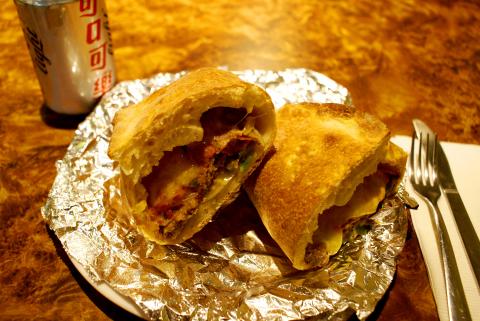“Best Stromboli you ever have!” reads the catchy caption at the top of Amore Pizzeria’s menu. That wouldn’t have been hard — I’d never had a Stromboli before entering Amore, which opened last month across the street from National Taiwan University on Xinhai Road. But after one bite of the fragrant, moist and meaty concoction that was presented to me 10 minutes after ordering, I was glad I had ordered it.
And there’s more to Amore. “Best pizza in town!” boasts a sign out front — fightin’ words. But they aren’t merely hyperbole. The homemade dough was rolled and baked into a crust that was just the right thickness, slightly crispy around the crimping and underneath, and chewy everywhere else. Mozzarella and a homemade sauce, infused with Italian herbs, covered the pie.
Amore Pizzeria’s space is plain — so plain that one could easily confuse it, as I initially did, for just another cheap knock-off pizza joint playing off guileless university students wanting a quick bite. Brown is the color of choice here: brown booths, brown tables, brown chairs and brown stools running along a brown bar. A few framed pictures — Michelangelo’s David, a caprese salad — break up the monotony.

Photo: Noah Buchan, Taipei Times
Though the decor is drab, Amore’s amiable owner, James Chen (陳建堂), knows what he’s doing. Having learned to cook Italian food in the early 1980s in New Jersey from an old Italian who ran six restaurants, Chen spent the past three decades perfecting what he does best: pizza.
He shuttered his three New Jersey shops in 2008 following the financial downturn, returned to Taipei after a 30-year hiatus and found the pizza here was not to his liking. “What is this ketchup and sugar?” he says.
Chen uses extra-virgin olive oil in his dough (which he blesses, Catholic style, before quartering it off and rolling it up) and in his Caesar salad dressing (which had a rich anchovy and caper finish). He makes the sausage and meatballs himself from scratch — again, learned from the New Jersey Italian — as he does the pasta sauces.
Stromboli is a turnover pizza similar to a calzone, but its dough is thicker. Chen said calzones are often made with ricotta, whereas Stromboli are made with mozzarella. The base is a vegetarian combination of onion, green pepper, tomato sauce and cheese, to which I added pepperoni and sausage (NT$320).
First, a warning: The Stromboli comes to the table piping hot and doesn’t cool off for quite a while, which can be dangerous. Generous slices of slightly spicy pepperoni and peppery sausage were evenly placed throughout the inside, so that a meaty morsel was found in every bite of bread.
Amore’s 12-inch supreme pizza (NT$480) earns its moniker. I haven’t seen so many toppings — sausage, meatball, pepperoni, green pepper and onion — for a long time. It may be possible that there are too many toppings. A rare case of too much of a good thing.

Most heroes are remembered for the battles they fought. Taiwan’s Black Bat Squadron is remembered for flying into Chinese airspace 838 times between 1953 and 1967, and for the 148 men whose sacrifice bought the intelligence that kept Taiwan secure. Two-thirds of the squadron died carrying out missions most people wouldn’t learn about for another 40 years. The squadron lost 15 aircraft and 148 crew members over those 14 years, making it the deadliest unit in Taiwan’s military history by casualty rate. They flew at night, often at low altitudes, straight into some of the most heavily defended airspace in Asia.

Taiwan’s democracy is at risk. Be very alarmed. This is not a drill. The current constitutional crisis progressed slowly, then suddenly. Political tensions, partisan hostility and emotions are all running high right when cool heads and calm negotiation are most needed. Oxford defines brinkmanship as: “The art or practice of pursuing a dangerous policy to the limits of safety before stopping, especially in politics.” It says the term comes from a quote from a 1956 Cold War interview with then-American Secretary of State John Foster Dulles, when he said: ‘The ability to get to the verge without getting into the war is

Beijing’s ironic, abusive tantrums aimed at Japan since Japanese Prime Minister Sanae Takaichi publicly stated that a Taiwan contingency would be an existential crisis for Japan, have revealed for all the world to see that the People’s Republic of China (PRC) lusts after Okinawa. We all owe Takaichi a debt of thanks for getting the PRC to make that public. The PRC and its netizens, taking their cue from the Chinese Communist Party (CCP), are presenting Okinawa by mirroring the claims about Taiwan. Official PRC propaganda organs began to wax lyrical about Okinawa’s “unsettled status” beginning last month. A Global

Like much in the world today, theater has experienced major disruptions over the six years since COVID-19. The pandemic, the war in Ukraine and social media have created a new normal of geopolitical and information uncertainty, and the performing arts are not immune to these effects. “Ten years ago people wanted to come to the theater to engage with important issues, but now the Internet allows them to engage with those issues powerfully and immediately,” said Faith Tan, programming director of the Esplanade in Singapore, speaking last week in Japan. “One reaction to unpredictability has been a renewed emphasis on